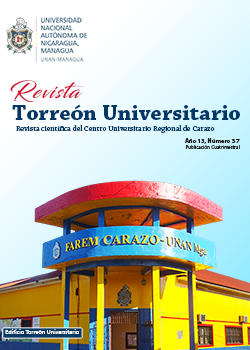Spanish as a foreign language course design according to learning needs
DOI:
https://doi.org/10.5377/rtu.v13i37.18174Keywords:
Needs analysis, Course design, Communicative forms, Target group, Communicative proposalsAbstract
The teaching of Spanish to foreigners for specific purposes is a relatively new discipline and has some characteristics that differentiate it from the teaching of Spanish in general. In this sense, this type of teaching is gaining more and more importance for socioeconomic and social reasons because more and more people are interested in learning a language focused on a specific purpose, as in the case discussed in this systematization in which attention was given to students with specific purposes. Hence, the main objective of this work is to describe the learning process and research on the learning needs of the target group to learn Spanish, who as a whole had clearly defined needs, focused on economic and social issues, since they are a group dedicated to the construction of horizontal works. The research was conducted using a qualitative approach. This methodology allowed the application of instruments and techniques with which it was possible to have a significant and direct impact on the target group (trainees). For the collection of information, an in-depth interview questionnaire was used to characterize the target group. To process the information obtained, the actions were divided into three fundamental phases, and interpretative analysis and characterization of elements were also used, for which a double-entry matrix was prepared, as well as analysis of the discourses. Theoretical and empirical methods made it possible to carry out an integral analysis (radiography) of the target group. The information triangulation technique was also applied and the relationship between the group's objectives and the contents to be developed was considered. The results of this research led to the proposal of a new line of research: a proposal or design of a course with specific purposes, especially for the personnel of the requesting institution.
Downloads
References
Alcaraz Andreu, C. (s. a http://cvc.cervantes.es/ensenanza/biblioteca_ele/asele/pdf/17/17_0205.pdf.
Ellis, R. (1995). La motivación y la edad en la enseñanza de Lengua Extranjera en el contexto de intereses. Madrid, Alhambra Longman en funiber.
Lozano, D., & Plácido Ruiz , C. (1996). Criterios para el diseño y la evaluación de cursos y diseños de materiales comunicativos . Cuadernos de tiempo libre.
Zasón, J. (1990). Psicología y didáctica de las lenguas: una aproximación históricas y conceptual.
Downloads
Published
Issue
Section
License
Copyright (c) 2024 National Autonomous University of Nicaragua, Managua

This work is licensed under a Creative Commons Attribution-NonCommercial-NoDerivatives 4.0 International License.
The authors who publish in this journal agree to the following terms.
- The author or authors of the articles, essays or research grant the National Autonomous University of Nicaragua, Managua (UNAN-Managua) the editing rights (copyright) of the submitted work, therefore the University has the exclusive right to publish the article for the entire copyright period.
- These copyrights/authors authorize Torreón Universitario Magazine and the University to edit and disseminate/publish the article in said Magazine, including printed and electronic reproduction, storage, retrieval and any other type of publication, and sources of secondary information as services. of summaries and databases, they also empower it to protect the article against unauthorized use for dissemination by printed or electronic media (PDF, HTML, EPUB, XML or others).
License for use of content
The magazine uses the Creative Commons Attribution-NonCommercial-NoDerivs 4.0 International License.
Under this statement:

This journal is licensed under a Creative Commons Attribution-NonCommercial-NoDerivatives 4.0 International License. It can be copied, distributed and transmitted publicly as long as the author and source are cited (Revista Torreón Universitario), it should not be modified or used for any commercial purpose. The full license can be found at http://creativecommons.org/licenses/by-nc-nd/4.0/.



